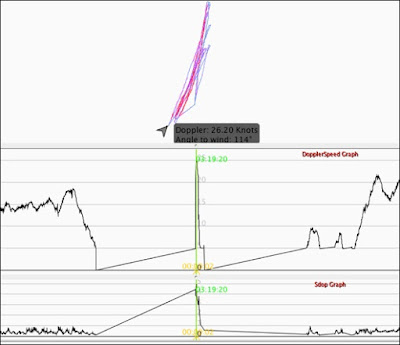This is a geeks only post. You've been warned.
I love my GW-60 GPS watch, and it has worked great for me. However, recent problems with accuracy that both Boro and Denis on our team had seen made me wonder how often such issues arise. I had never seen them in my data, and I often looked closely enough that I would discover them. But many speedsurfers just quickly analyze the data to get their speeds, and upload those speeds, trusting whatever the software tells them.
So I went on a little fishing expedition on ka72.com. I searched for downloadable GPS sessions from May 15, 2017 onwards, and downloaded data files that were from GW-60 watches. Then, I looked at the tracks in detail in GPS Action Replay Pro and GPSResults, searching for examples where the 2 second speed was overstated.
After checking 15 files, I found one with a problem: the top speed was just a few seconds of 25-knot speeds, in the middle of what looked like a longer swim. That's not how top speeds are reached! Sure enough, the GPS analysis software came to different results: Ka72.com and GPSResults gave a top speed of 25.3 knots, but GPSResults gave only 21.37 knots - 4 knots less! Let's look at the data:
This windsurfer had set up his watch to record only if the minimum speed exceeded 5 knots. The middle graph shows the speed: it was below 5 knots for about 4 minutes, with a few seconds where he supposedly sailed a lot faster than during the test of his session. The tracks on top show that this was at the very end of a run, after turning around - very suspicious! The accuracy graph at the bottom confirms the suspicions: the watch new that it did not have good data, and gave the data near the spike a much higher error estimate than the test of the track. Which, by the way, is why GPSResults did not include this region when it looked for top speeds.
Here are the data points in this region:
All data points in this regions have +- numbers between 3.2 and 4.957 - in other words, they are junk and should be ignored. For this screen shot, I forced GPSResults to behave badly by turning the filters off. The two other analysis programs, GPS Action Replay and ka72.com, always behave badly with data like this - they do not have SDoP filters.
In both this and the previous example of speed artifacts, the errors occurred during prolonged times where the windsurfer apparently was in the water, probably swimming, trying to waterstart, or resting. In such situations, GPS watches are more prone to artifacts because of where they are typically worn: on the wrist (instead of on the upper arm or helmet like other GPS devices). That means the watch will be under water much more than a GT-31 or GW-52 GPS, not getting any GPS reception because water absorbs the GPS signal. But at times, the watch may be close to or just above the water, and get a signal for a short time. At that point, the GPS chip has to re-acquire the satellites, and calculate the current position from scratch - which can introduce big errors, especially if the reception is marginal. In the tracks and the non-doppler speed graphs, there are often big jumps and spikes when this happens. Usually, that's not a problem with doppler speeds (which is exactly why we use doppler speeds for GPS speedsurfing!): single speed spikes from position adjustments just disappear in the doppler speeds. But when swimming with the watch close to the surface, we sometime see multiple spikes in the speed graphs. When that happens, the error can "go through" to the calculated doppler speeds, which is what we see in the graphs above.
Many speedsurfers may never see issues like this one because they sail in shallow locations, nail their jibes, and/or waterstart quickly very time they crash. But if you have a session where you spend a considerable amount of time in the water, then the chances of errors like the one described here are significant. Sometimes, it's obvious - Denis knew he had not set a new world record. Other times, it's not; in the example above, the 2 second speed seems reasonably close to the 10 second speeds, at least at first glance, so the result was posted to the GPS Team Challenge. In this case, it did not affect anything; but similar problems could happen during faster sessions that count for the monthly ranking.
While this particular problem here may be specific to GPS watches, and maybe even the GW-60 watch, I have seen similar artifacts in GPS data from all kinds of devices, including the long-time "gold standard" GT-31. Typically, it's easy to recognize such problems if you look at the your GPS traces, and examine your doppler speed graphs for the top speeds. In GPS Action Replay, I also find the "SDoP" graph quite useful to identify problem areas. I don't find GPSResults quite as intuitive, but then, GPSResults does a much better job at filtering out problem areas automatically, so the results are more likely to be accurate in the first place. Hopefully, we'll also see similar automatic filtering soon on ka72.com and in GPS Action Replay Pro.
Best session of the year - so far!
2 days ago

